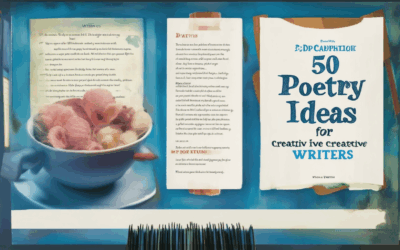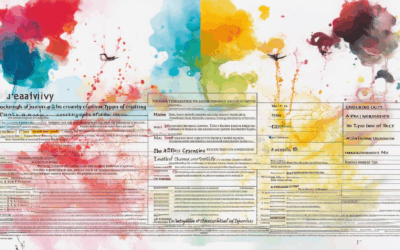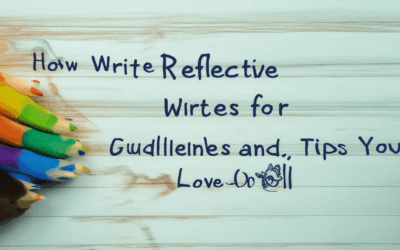Writing effective creative writing essays can be both challenging and rewarding, requiring a blend of creativity, structure, and clarity. Whether you’re a seasoned writer or just beginning, mastering the craft of crafting compelling essays is essential for conveying your unique voice and ideas. This guide will walk you through the key strategies, tips, and examples needed to excel in creative writing, ensuring your work stands out while resonating with readers.
Key Takeaways
- Dive into the rich tapestry of creative writing forms, including fiction, poetry, drama, screenwriting, erotica, and hybrid genres, each catering to distinct interests and goals.
- Grasp the essentials of creative writing with the 4 Cs: Clarity for effective communication, Completeness for thorough exploration, Conciseness for brevity, and Correctness for polished craftsmanship.
- Elevate your storytelling by mastering “Show, Don’t Tell” – using descriptive techniques to immerse readers in your narrative.
- Engage with vibrant communities and unlock resources to refine your craft and connect with fellow writers passionate about storytelling.

What Are Good Topics for Creative Writing?
- Fantasy Worlds: Create magical realms, mythical creatures, and epic adventures.
- Horror and Suspense: Explore dark themes, psychological tension, and eerie atmospheres.
- Mystery and Crime: Craft intricate plots with unexpected twists and enigmatic characters.
- Romance and Love Stories: Delve into heartfelt relationships, passionate encounters, and emotional journeys.
- Science Fiction Futures: Imagine groundbreaking technologies, alien civilizations, and parallel universes.
- Historical Fiction: Bring history to life through vivid reenactments and character-driven narratives.
- Comedy and Satire: Use humor, absurdity, and irony to comment on modern life and societal issues.
- Personal Reflection: Write about personal experiences, emotions, and introspective thoughts.
- Dystopian Nightmares: Depict alternate realities where society faces catastrophic challenges.
- Friendship and Family Dynamics: Explore complex relationships and emotional family sagas.
- Food and Cooking: Celebrate culinary traditions, unique recipes, and food-related adventures.
- Environmental and Social Issues: Address climate change, social justice, and global challenges.
- War and Peace: Portray the human cost of conflict and the pursuit of harmony.
- Supernatural and Paranormal: Investigate ghosts, vampires, witches, and other mysterious forces.
- Children’s and Young Adult Stories: Craft tales filled with magic, adventure, and coming-of-age moments.
- Flash Fiction: Write brief, impactful stories that pack a punch in just a few paragraphs.
- Experimental Forms: Try innovative structures like nonlinear storytelling or stream-of-consciousness writing.
These topics can inspire endless creative possibilities and spark your imagination. Whether you’re writing for fun, school, or publication, these ideas can help you get started. Remember to let your unique voice shine and stay true to your vision!
How to Start a Creative Writing Essay
To craft an engaging and effective opening for your creative writing essay, follow these organized steps:
- Grab Attention with a Captivating Opening: Begin with a memorable sentence or anecdote that hooks the reader. For instance, “Imagine finding a mysterious journal in the attic…”
- Choose a Theme or Genre: Decide on the type of writing you want to pursue—whether it’s a personal narrative, a fantasy story, or a reflective essay.
- Develop a Strong Hook: Use a question, surprising fact, or intriguing statement to draw readers in. Examples include posing a problem or sharing an unexpected truth.
- Create a Detailed Outline: Plan your essay by listing main points and supporting details. This ensures your essay has a clear structure and purpose.
- Set a Consistent Tone and Style: Determine if your essay will be humorous, reflective, or dramatic. Maintain this tone throughout to keep the essay coherent.
- Craft a Thoughtful Title: Choose a title that reflects your essay’s content and appeals to readers. Consider themes or emotions central to your story.
- Write a Compelling Introduction: Combine the elements above into a paragraph that introduces your topic, engages the reader, and presents your thesis statement.
By following these steps, you’ll create a powerful introduction that captivates readers and sets the stage for a well-structured essay. Keep your language clear and your voice consistent to maintain engagement throughout your writing.

The Best Topic for Essay Writing
Choosing the best topic for an essay involves considering your interests, the availability of resources, and the potential for meaningful exploration. Here are some structured thoughts to guide your decision:
- Interests and Passions:** Focus on subjects that excite you. Whether it’s history, literature, technology, or personal experiences, selecting an area you’re passionate about ensures engagement.
- Niche Within a Broader Category:** Consider a specific aspect of a broader field. For example, instead of general “technology,” focus on “the impact of artificial intelligence on employment.”
- Personal Experiences:** Writing about personal challenges or achievements can add a relatable touch, though ensure it offers enough depth for a comprehensive essay.
- Audience Consideration:** Tailor the topic to your audience. For academic purposes, choose something substantial; for a personal blog, a heartfelt story might be suitable.
- Purpose of the Essay:** Determine if your essay aims to inform, persuade, or reflect. This will influence the tone and focus of your topic.
- Combining Aspects:** Consider topics that blend multiple areas, such as “how climate change impacts global economy and social structures,” offering comprehensive exploration.
- Research Availability:** Ensure there are adequate resources available on your chosen topic to facilitate thorough research.
- Time Management:** Balance breadth and depth based on available time, allowing for focused exploration without overwhelming complexity.
- Thesis Statement:** Choose a topic that supports a strong thesis, enabling structured exploration with multiple perspectives.
Based on these considerations, a well-chosen topic could be:
Example Topic: “The Role of Social Media in Modern Democracy”
This topic combines technology, society, and politics, offering rich angles for exploration. It allows for discussion of how social media influences political participation, spreads misinformation, and shapes public opinion. With ample research available, this topic balances depth and interest, making it ideal for a comprehensive essay.

Types of Creative Writing
Creative writing encompasses a wide array of forms, each offering unique storytelling techniques and perspectives. Here are seven primary types of creative writing:
- Fiction : This broad category includes novels, short stories, novelettes, novellas, and serials. Fiction can be genre-specific, such as mystery, romance, science fiction, fantasy, or horror.
- Non-Fiction : Unlike fiction, non-fiction is based on real events or personal experiences. It encompasses articles, blogs, essays, biographies, autobiographies, and memoirs.
- Poetry : Poetry involves the creation of lyrical works that express emotions, ideas, or imagery through words arranged in a structured format, often with rhyme and rhythm.
- Drama : Drama is the representation of scenes, actions, and characters in a sequence that tells a story. It can be performed on stage, in film, or in written form.
- Screenwriting : Writing for film, television, or other visual media requires crafting scripts that tell stories visually, incorporating dialogue, action, and scene descriptions.
- Erotica : Erotic writing focuses on themes of love, passion, and intimacy, often exploring adult relationships and desires in a fictional or non-fictional context.
- Hybrid Genres : These combine elements of two or more genres, such as speculative fiction (mixing science fiction and fantasy), literary journalism (blending narrative with reporting), or New Journalism (fusing investigative reporting with storytelling).
Understanding these types of creative writing allows writers to explore diverse styles and find the ones that resonate most with their interests and goals. Whether you prefer crafting intricate plots in fiction or documenting real-life experiences in non-fiction, there’s a form of creative writing for everyone.
What Are the 4 Cs of Creative Writing?
The Four Cs of creative writing are essential principles that guide writers in producing clear, engaging, and impactful content. These criteria help ensure that your work is not only meaningful but also effectively communicated to your audience.
1. Clarity
Clarity is the foundation of effective communication. Your writing should be easy to understand, free of ambiguity, and accessible to all readers. Use simple language, avoid jargon, and break complex ideas into digestible parts. For example, when explaining a concept, consider how a young child might understand it, ensuring that your message resonates broadly.
2. Completeness
Completeness ensures that your writing covers all aspects of your subject matter. This means exploring every angle of your topic thoroughly and providing a well-rounded perspective. Avoid leaving gaps in your narrative or omitting critical details that could provide deeper insight into your theme. Ensure that every part of your argument is supported and developed to its fullest potential.
3. Conciseness
Conciseness is about brevity and efficiency. Your writing should be as straightforward as possible, avoiding unnecessary fluff or repetition. Every sentence should contribute meaningfully to your overall message. Edit your work to eliminate redundancies and streamline your language, making it as impactful as possible without losing clarity.
4. Correctness
Correctness involves attention to detail and adherence to grammatical rules. Proper grammar, punctuation, and spelling are crucial for maintaining professionalism and credibility. Proofread your work carefully to catch errors and ensure that your writing reflects polished craftsmanship. A single typo or grammatical mistake can undermine the effectiveness of your message.
By focusing on these four Cs—Clarity, Completeness, Conciseness, and Correctness—you can create writing that is not only artistically fulfilling but also highly functional and accessible to your audience. Whether you’re crafting a novel, a poem, or a blog post, mastering these principles will help you communicate your ideas with confidence and precision.

What is the Golden Rule of Creative Writing?
The golden rule of creative writing, often referred to as “show, don’t tell,” is a fundamental principle that emphasizes the use of descriptive techniques to convey meaning through imagery, actions, and sensory details rather than directly stating it. This approach helps authors create a more immersive and relatable experience for readers.
Understanding the Show, Don’t Tell Technique
The show, don’t tell method involves illustrating scenes, emotions, and character traits through specific details rather than relying on exposition or dialogue. For example, instead of stating that a character is angry, a writer might describe their clenched fists, narrowed eyes, and rapid breathing to evoke that emotion.
Benefits of Using the Golden Rule
By showing rather than telling, writers allow readers to connect more deeply with the narrative. This technique fosters a stronger emotional connection and makes the story feel more authentic. It also enables the audience to visualize the setting and characters more vividly.
How to Apply the Golden Rule Effectively
- Use sensory details to paint a picture in the reader’s mind.
- Focus on actions that reveal character traits or motivations.
- Employ the use of point of view to provide insight into characters’ thoughts and feelings.
Exploring Creative Writing Communities
Silken Drum is a hub for creative writers, offering a space to share work, explore imaginative content, and engage in meaningful discussions. Our platform encourages writers to refine their craft and connect with like-minded individuals who share a passion for storytelling.
Resources for Further Exploration
For those looking to delve deeper into creative writing techniques, we recommend exploring resources from trusted platforms like Medium and Substack . These platforms offer valuable insights and inspiration for aspiring writers.
Conclusion
The golden rule of creative writing, “show, don’t tell,” is a cornerstone of effective storytelling. By immersing readers in the narrative through detail and action, writers can craft experiences that resonate long after the story is finished. At Silken Drum, we celebrate this principle and invite you to join our community of creators.




0 Comments